Community Read: Believing: Our Thirty-Year Journey to End Gender Violence by Anita Hill
- Details
- Written by Joanne Wallenstein
- Hits: 969
Scarsdale Family Counseling Service and the Scarsdale Safe Coalition, along with the Scarsdale Public Library and the Friends of the Library are sponsoring a community Book Read and follow up community program. They encourage residents to read Believing: Our Thirty-Year Journey to End Gender Violence by Anita Hill during the April vacation.
On April 19th at 7:30 PM, they will host a Virtual Evening with Anita Hill, with discussion facilitated by Pulitzer Prize winning columnist Nicholas Kristof. The program can be viewed either from home or on the big screen at the Scott Room at the Library. Register here.
The book can be borrowed from the library, or purchased with a 10% discount at the Bronx River Book Store.
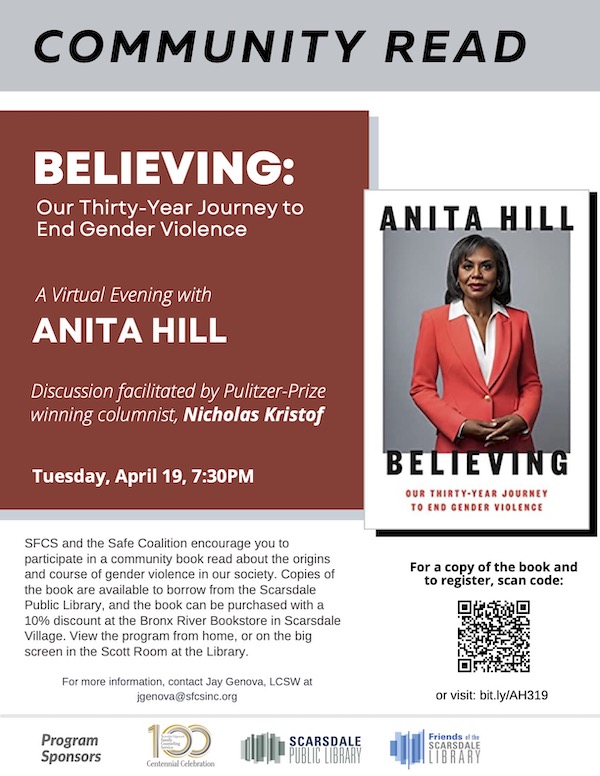
First Print Issue of Scientific Scarsdalian Shows Professionalism and Direction
- Details
- Written by Adam Katcher
- Hits: 1235
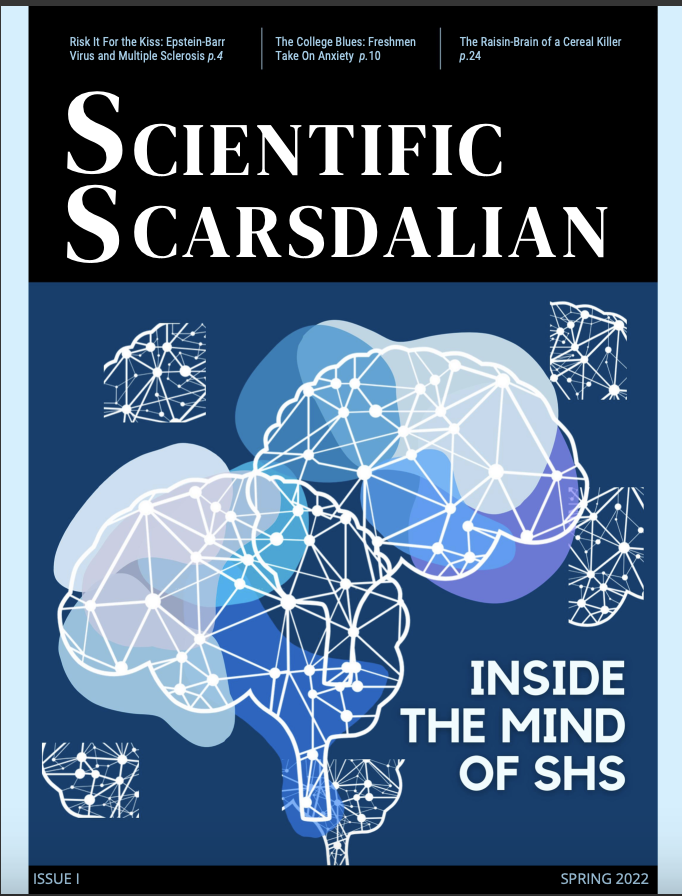 After months of researching, writing, editing, designing, printing, and much more, Cindy DeDianous, Matthew Barotz, Simone Glajchen, and other members of the Scientific Scarsdalian STEM publication finally got the opportunity to distribute their first in-print issue. The science focus, literary aspect and artistic appeal made the magazine the talk of the school. The relatively-young club has a fruitful future ahead of them, as shown by the present progress.
After months of researching, writing, editing, designing, printing, and much more, Cindy DeDianous, Matthew Barotz, Simone Glajchen, and other members of the Scientific Scarsdalian STEM publication finally got the opportunity to distribute their first in-print issue. The science focus, literary aspect and artistic appeal made the magazine the talk of the school. The relatively-young club has a fruitful future ahead of them, as shown by the present progress.
DeDianous, Barotz, and Glajchen are scientists and journalists who might be mistaken for professionals, though they are still in high school.
At the beginning of March, when members of the Scientific Scarsdalian club stood at the entrances handing out copies of their first issue, people were in for a pleasant surprise. Rather than receiving a nice-looking magazine student publication, they were handed a scientific magazine of a special quality. This issue, centered on psychology, discussing topics such as illusions, dreams, seasonal depression, optogenetics, the bystander effect, and much more. The complex crossword puzzle cannot be forgotten either.
Editor-in-chief DeDianous was proud of how the first edition came out and has high aspirations for the future of the club/STEM-based magazine.
“One thing that was really important,” explained DeDianous, “is that the articles are engaging and accessible because a lot of times, people don’t read about science; it can be super dense and hard to get into if you don’t have background knowledge. We wanted to make sure everyone, no matter what knowledge they had, could gain something from it and find it interesting and want to come back to it.”
The result was a publication that was accessible but at the same time sophisticated enough to provide readers with new information to learn. DeDianous said, “People who like both humanities and STEM and art can join the club and have the chance to write about interesting topics, both on the more technical side and more interesting curiosity about the world around us. It’s a really great place for people of different interests to mix. We have a graphics team, writing team, and all of that.”
The club as it is known today was only founded last year, with a website as the sole hub for their articles, and the goal of producing an issue in print so that it “can be shared with the entire Scarsdale community.” There have been previous attempts to create a “Scientific Scarsdalians,” club, but these were unsuccessful. This new club hosts the website which you can see here, (https://scientificscarsdalian.org/), and is gaining traction through the print edition and articles online.
The next magazine is already in progress, “We are thinking of doing an environmental theme for the next issue. For example, something that is Scarsdale-related is our compost system. There are lots of interesting details behind it, but most people don’t know how it really works,” shared DeDianous.
This ties into the greater them of what makes the Scientific Scarsdalian truly the official STEM magazine of Scarsdale, rather than just another generic science magazine. The club aims to introduce as many local elements as possible to their issues. There are some student-led studies that do not tie back to Scarsdale necessarily, but all of the articles either mention ties to the community or are conducted by the young scientists within the community.
DeDianous describes the club community as a welcoming, interesting place, saying, “I think our teamwork is a really important aspect of encouraging people to work together on articles or peer edit, get feedback from both the officers as well as other writers to really get multiple eyes on something and take different perspectives into account. At meetings, we brainstorm, outline, write, edit, and other times we mix in fun events, such as Kahoots to change things up and test people on their scientific knowledge.”
The budding club will only continue to grow as the years pass and their magazine could soon become the main “resource for Scarsdalians to get scientific information that they might not be able to get otherwise.”
Scientific Scarsdalian Club Officer list:
Editors-in-Chief: Simone Glajchen and Cindy DeDianous
News Editors: Jaden Tepper and Rose Kinoshita
Opinion Editor: Matthew Barotz
Feature Editor: Irene Li
Creative Director: Olivia Liu
Former Public Defender Uses Her Experience to Inspire a Novel
- Details
- Written by Joanne Wallenstein
- Hits: 1769
 Local author Reyna Marder Gentin has just published her third book, Both are True, and will speak at the Scarsdale Library on Thursday night March 10 at 7:30 pm. Register here:
Local author Reyna Marder Gentin has just published her third book, Both are True, and will speak at the Scarsdale Library on Thursday night March 10 at 7:30 pm. Register here:
Gentin is a lawyer who left her practice as a criminal appellate attorney in the public defender’s office in 2014 and decided to try something new. She enrolled in a writing class at The Writing Institute at Sarah Lawrence College and used her work as a public defender to inspire her work. She published her first novel, Unreasonable Doubts, followed by My Name Is Layla. Now with Both Are True, Reyna has returned to women’s fiction, the law, and New York City.
About her life in town Gentin says, “My husband and I moved here 25 years ago, when we were expecting our first child. One of our favorite parts about living here is the small-town feel of our neighborhood. Across from our house is a small pond situated on a grassy green, and I love when the weather warms up and the ducks return. Our children looked forward every year to the annual picnic in the spring, where the streets are closed off and a neighbor leads the kids in relay races, a tug of war, and an egg toss. One year there was a thunderstorm right in the middle of the picnic, and we sheltered the neighbors on our front porch until the rain passed. Now that the kids are grown and living on their own, we all look back so fondly on the time we’ve spent together here.”
We asked Gentin if we could share a preview of Both Are True with our readers and here is what she shared. Explaining the story she said:
Judge Jackie Martin's job is to impose order on the most chaotic families in New York City. So how is she blindsided when the man she loves walks out on her?
Jackie Martin is a woman whose intelligence and ambition have earned her a coveted position as a judge on the Manhattan Family Court-and left her lonely at age 39. When she meets Lou Greenberg, Jackie thinks she's finally found someone who will accept her exactly as she is. But when Lou's own issues, including an unresolved yearning for his ex-wife, make him bolt without explanation, Jackie must finally put herself under the same microscope as the people she judges. When their worlds collide in Jackie's courtroom, she learns that sometimes love's greatest gift is opening you up to love others.
In this scene, we see Jackie on the bench as she presides over a case where a mother is charged with neglecting her children.
Here is an excerpt from the book:
“What’s on tap, Angela?” Jackie perused the docket sheet, but she was never good with names. The list was a long litany of abandonment, abuse, domestic violence, drugs, neglect, juvenile delinquency. Only once in a while did Jackie preside over something happy, an adoption or a family reunification. In the short time she’d been in the job, she’d come to recognize that although she did her best to discern the underlying dynamics of each situation, to be decisive and fair, much of the time she had little idea what was really going on. And even less ability to fix the problems. It was a state of affairs that would make any control freak’s skin crawl.
“All continued hearings on cases you’ve already seen,” Angela said. “Only one new matter, Clark. A neglect. Here’s the petition.” She pulled it up on Jackie’s monitor.
The charges named only the mother, Darlene Clark. The fathers were often missing in action, as though these troubled families had sprung from a vast maternal pool without any male input. Jackie had calculated the percentage of her docket that involved single moms and it was staggering, although the cause and effect wasn’t clear. Were the children neglected or turning to crime because they had no male role models, or did the fathers abandon ship when the situation at home became unsalvageable? Either way, the mothers were often left holding the diaper bag.
This mom, Darlene Clark, was accused of neglecting her two daughters, ages seven and five. According to the Department of Social Services, Clark had failed to ensure the girls’ attendance at school, not taken them for routine medical care and inoculations, and not fed them sufficiently. The allegations were serious but didn’t rise, yet, to the level of abuse. Maybe with intensive court-ordered support and education, Ms. Clark could turn this around. Jackie hoped so.
She disposed of the first few cases quickly. When her chief court officer, Mike, called the Clark case, Jackie looked up from her computer screen. She motioned to Angela, who was immediately by her side.
“What are those kids doing in here?” Most of the children who appeared before Jackie were of the teenage juvenile delinquent variety, boys and girls 14 or 15 years old who would’ve faced real time in a real prison if they’d been a year or two older and prosecuted as adults. Jackie hardly ever saw the children who were the subjects of the neglect or abuse cases. They were either already in protective custody, or, if it was safe for them to remain living at home while the case proceeded, they were waiting in the daycare on the second floor while the mothers appeared in court. There was no reason to drag them here. Yet here they were, two girls carefully dressed for the occasion in matching denim shorts and purple t- shirts. They looked underweight, but not alarmingly so. Jackie watched as Mike gently led them away from their mother and seated them in the back. He handed them each two chocolate kisses from the glass jar Angela kept on her desk.
“Potential in-court removal. Imminent risk of harm,” Angela said, leaning over to speak in Jackie’s ear.
“Excuse me?” Jackie had seen a lot during her brief time on the bench, but this was something new.
“I spoke to the caseworker from Child Protective Services after the petition was filed this morning. She said that when the school nurse called in the neglect, the agency tried to evaluate the children and assess the situation. The caseworker went to the home on three separate occasions. Each time the mother claimed the kids weren’t home and wouldn’t let her in to look for them.”
“So, what are the kids doing here?” Jackie asked.
“Sometimes, instead of involving the police right away when the parent is uncooperative, the caseworker gives the mother a final chance and directs her to bring the children to court. The mother gets scared and usually complies. Depending on what the caseworker finds when she sees the kids, she has the authority to remove them into protective custody. Here, in the courtroom,” Angela said. “You’ll still have to determine if the removal is indicated down the line. This is a temporary, emergency measure.”
“You’re telling me it’s possible that we’re going to ambush this mother and take her children from her right in front of Ms. Lopez from the Judicial Review Panel?” Jackie swallowed hard, willing herself to stay calm.
“Afraid so, Judge.”
“This can’t be happening…”
As she spoke, the caseworker, flanked by two additional court officers who appeared out of nowhere, escorted the Clark children from the courtroom in stunned silence. Darlene Clark, who may not have completely understood the legal ramifications of what was happening, understood enough. She let out an ear-splitting wail, a blaring distress signal emanating from the deepest core of her being.
That keening—so unnatural and otherworldly—sent Jackie back to her parents’ house on Long Island . . .
She’s ten years old and it’s springtime. On top of a bush that abuts the front porch, a robin has built a nest. The eggs are blue. She understands why the color is called robin’s egg blue, because it has an intensity of identity and a purity she’s never seen anywhere else. Before and after school Jackie checks on the nest, watches the mother sitting protectively on the eggs. A couple of weeks pass and miraculously the tiny baby birds hatch. Now both mother and father go back and forth to the nest, sustaining the young with worms. Jackie loves the birds like they are the pets her mother has never allowed.
One afternoon, Jackie is inside playing the piano. Over the sound of her oft-practiced but never perfected Fur Elise, she hears the most piercing, grief-filled sound. That keening. When she races to the window, a hawk is inches from the nest. The mother bird is inconsolable. It’s a sound that Jackie never would have thought the bird capable of making, a howling so profound. Jackie bangs on the window and flails her arms, shouting at the hawk, “Drop the baby bird, drop him!” The hawk flies away, baby bird in its mouth, while the robin’s death knell continues. In another moment, the mother bird quiets and turns back to the nest. Jackie imagines her finding the strength to comfort the babies that are left after a loss that is unfathomable. The father, attentive when times were good, is nowhere to be seen.
And now this woman in her courtroom was making that same sound.
Sign up to hear Gentin on Thursday night March 10 here, or buy the book on Amazon here or or from Bronx River Books.
Author Dorothy Wickenden at Scarsdale Library
- Details
- Written by Joanne Wallenstein
- Hits: 1310
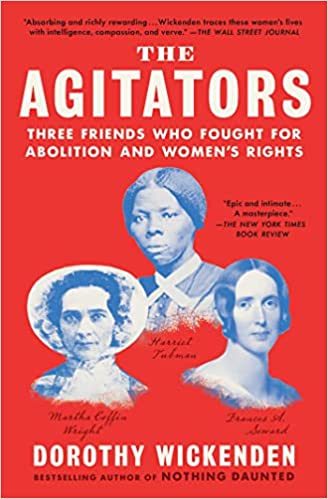 Dorothy Wickenden, author of The Agitators: Three Friends Who Fought for Abolition and Women’s Rights, will discuss her book at the Scarsdale Public Library on Sunday April 3 at 3:00 pm. The event is hosted by the League of Women Voters Scarsdale and the Scarsdale Public Library, admission is free and all members of the public are welcome. Please RSVP here.
Dorothy Wickenden, author of The Agitators: Three Friends Who Fought for Abolition and Women’s Rights, will discuss her book at the Scarsdale Public Library on Sunday April 3 at 3:00 pm. The event is hosted by the League of Women Voters Scarsdale and the Scarsdale Public Library, admission is free and all members of the public are welcome. Please RSVP here.
The Agitators tells the story of America before the Civil War through the lives of three women who advocated for the abolition of slavery and for women’s rights as the country split apart: Harriet Tubman, Martha Coffin Wright, and Frances A. Seward.
In the 1850s, Harriet Tubman, strategically brilliant and uncannily prescient, rescued some seventy enslaved people from Maryland’s Eastern Shore and shepherded them north along the underground railroad. One of her regular stops was Auburn, New York, where she entrusted passengers to Martha Coffin Wright, a Quaker mother of seven, and Frances A. Seward, the wife of William H. Seward, who served over the years as governor, senator, and secretary of state under Abraham Lincoln. During the Civil War, Tubman worked for the Union Army in South Carolina as a nurse and spy and took part in a spectacular river raid in which she helped to liberate 750 slaves from several rice plantations.
Wright, a “dangerous woman” in the eyes of her neighbors, worked side by side with Elizabeth Cady Stanton and Susan B. Anthony to organize women’s rights and anti-slavery conventions across New York State, braving hecklers and mobs when she spoke. Frances Seward, the most conventional of the three friends, hid her radicalism in public, while privately acting as a political adviser to her husband, pressing him to persuade President Lincoln to move immediately on emancipation.
The Agitators opens in the 1820s, when Tubman is enslaved and Wright and Seward are young homemakers bound by law and tradition and ends after the war. Many of the most prominent figures of the era—Lincoln, William H. Seward, Frederick Douglass, Daniel Webster, Charles Sumner, John Brown, William Lloyd Garrison—are seen through the discerning eyes of the protagonists. So are the most explosive political debates: about the civil rights of African Americans and women, about the enlistment of Black troops, and about opposing interpretations of the Constitution.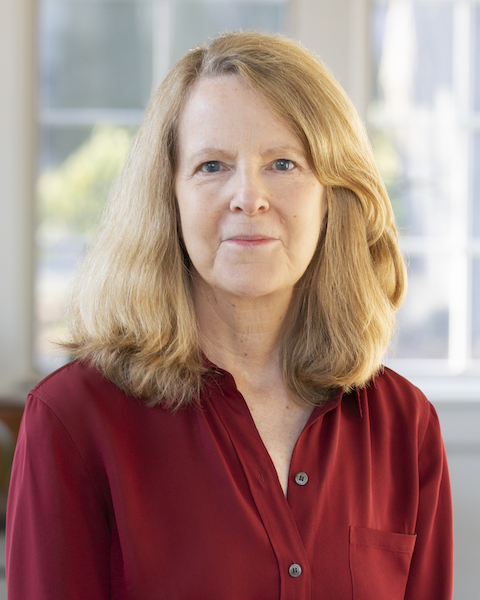 Dorothy Wickenden
Dorothy Wickenden
Through richly detailed letters from the time and exhaustive research, Wickenden traces the second American revolution these women fought to bring about, the toll it took on their families, and its lasting effects on the country. Riveting and profoundly relevant to our own time, The Agitators brings a vibrant, original voice to this transformative period in our history.
Dorothy Wickenden is the author of Nothing Daunted and The Agitators and has been the executive editor of The New Yorker since January 1996. She also writes for the magazine and is the moderator of its weekly podcast The Political Scene. A former Nieman Fellow at Harvard, Wickenden was national affairs editor at Newsweek from 1993-1995, and before that was the longtime executive editor at The New Republic.
The paperback edition of The Agitators is available for purchase with a 10% discount at Bronx River Books. For phone, email, and in-store purchases, mention LWVS to receive the 10% discount.
To attend, please RSVP here.
For more information, contact Alissa Baum at lwvspresident@gmail.com.
Hoff-Barthelson’s Celebration of Music from 1750 - 1950
- Details
- Written by Joanne Wallenstein
- Hits: 1022
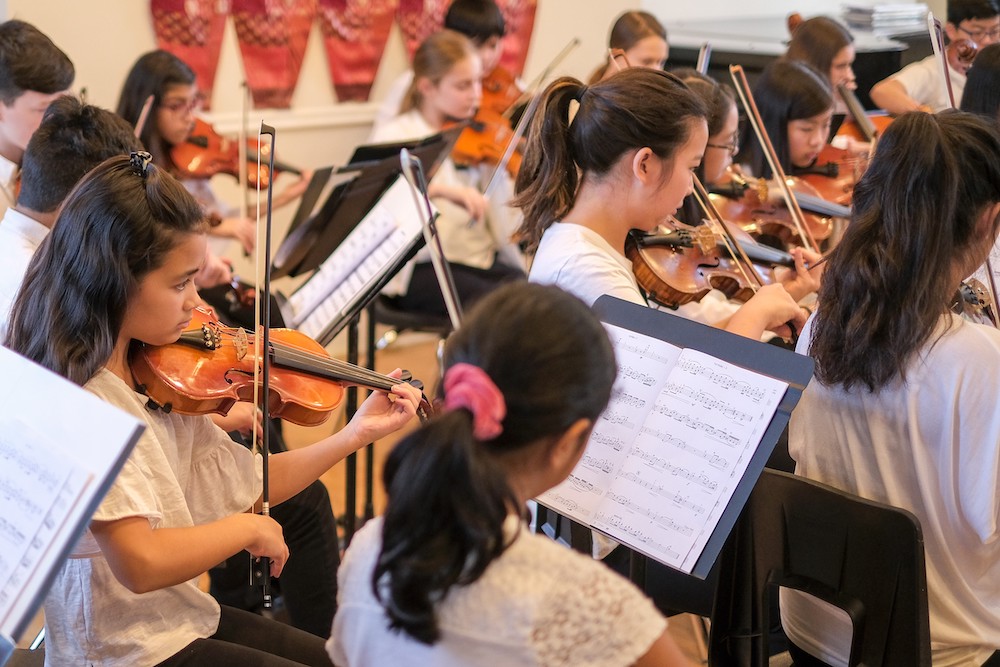 Hoff-Barthelson Music School’s Spanning the Centuries Music Festival, celebrating music composed between 1750 and 1950, takes place Friday, March 12, 2022, through Saturday, March 19, 2022. The Festival, featuring music of the great Germanic composers – Haydn, Mozart, Beethoven, Schubert and Brahms – as well as masters from other lands, includes student recitals and instrumental and choral ensemble concerts.
Hoff-Barthelson Music School’s Spanning the Centuries Music Festival, celebrating music composed between 1750 and 1950, takes place Friday, March 12, 2022, through Saturday, March 19, 2022. The Festival, featuring music of the great Germanic composers – Haydn, Mozart, Beethoven, Schubert and Brahms – as well as masters from other lands, includes student recitals and instrumental and choral ensemble concerts.
Spanning the Centuries is part of the School’s “Festivals in Style” that introduces students to music from specific periods of music. Students enjoy the opportunity for detailed study of period solo and ensemble works and are invited to audition to participate in recitals. Auditions are adjudicated by faculty panels. “Experiencing the audition process is an important learning experience for every music student, thus Spanning the Centuries provides vital opportunities for students at all levels to become acquainted with the rigors of auditioning – a character building experience second to none!” said Executive Director Ken Cole.
On Saturday, March 13, and Sunday, March 14, 2024, at 7:00 pm, student performances will take place at the Community Unitarian Universalist Congregation, 468 Rosedale Avenue, White Plains. Ensembles scheduled to perform include the Festival Orchestra (Jun Nakabayashi, director); Suzuki Strings (Barbara Berg, director); Flute Clubs (Donna Elaine and Joseph Piscitelli, directors); Symphonette and Chamber Orchestra (Robert Schwartz, director); Wind Ensemble (Joseph Piscitelli, director); Beginner Voices (Yuki Hiruma, director); and Junior Voices (Jennifer Tibbetts, director). Admission is $20. HBMS students may attend free of charge.
Reservations are required and can be made by visiting www.hbms.org, e-mailing hb@hbms.org or by calling 914-723-1169.
Student recitals are scheduled at the Music School throughout the Festival. Visit the School website – www.hbms.org – for dates and times. These recitals are free of charge.
(Photo Credit Steven Schnur)













